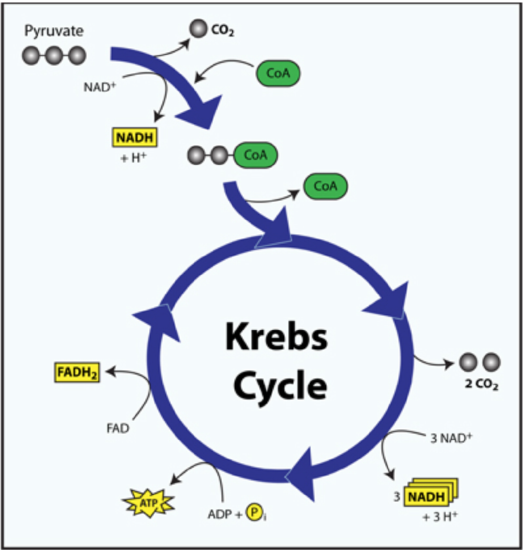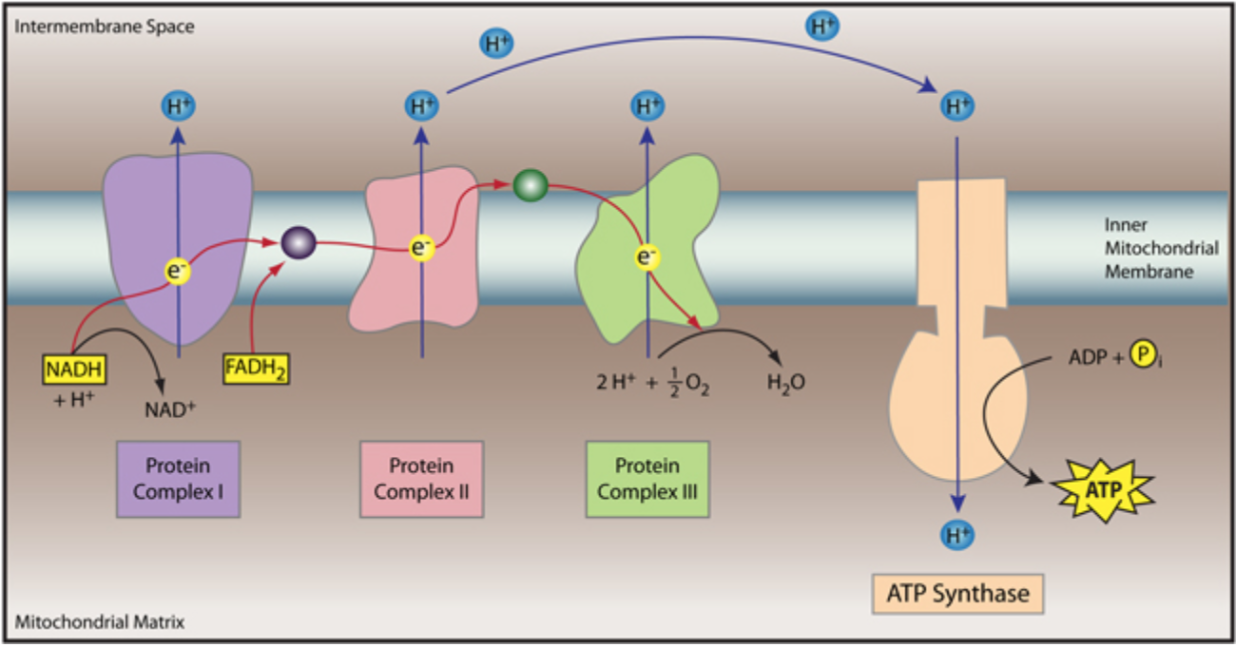Cellular Respiration
- Page ID
- 23978
\( \newcommand{\vecs}[1]{\overset { \scriptstyle \rightharpoonup} {\mathbf{#1}} } \)
\( \newcommand{\vecd}[1]{\overset{-\!-\!\rightharpoonup}{\vphantom{a}\smash {#1}}} \)
\( \newcommand{\id}{\mathrm{id}}\) \( \newcommand{\Span}{\mathrm{span}}\)
( \newcommand{\kernel}{\mathrm{null}\,}\) \( \newcommand{\range}{\mathrm{range}\,}\)
\( \newcommand{\RealPart}{\mathrm{Re}}\) \( \newcommand{\ImaginaryPart}{\mathrm{Im}}\)
\( \newcommand{\Argument}{\mathrm{Arg}}\) \( \newcommand{\norm}[1]{\| #1 \|}\)
\( \newcommand{\inner}[2]{\langle #1, #2 \rangle}\)
\( \newcommand{\Span}{\mathrm{span}}\)
\( \newcommand{\id}{\mathrm{id}}\)
\( \newcommand{\Span}{\mathrm{span}}\)
\( \newcommand{\kernel}{\mathrm{null}\,}\)
\( \newcommand{\range}{\mathrm{range}\,}\)
\( \newcommand{\RealPart}{\mathrm{Re}}\)
\( \newcommand{\ImaginaryPart}{\mathrm{Im}}\)
\( \newcommand{\Argument}{\mathrm{Arg}}\)
\( \newcommand{\norm}[1]{\| #1 \|}\)
\( \newcommand{\inner}[2]{\langle #1, #2 \rangle}\)
\( \newcommand{\Span}{\mathrm{span}}\) \( \newcommand{\AA}{\unicode[.8,0]{x212B}}\)
\( \newcommand{\vectorA}[1]{\vec{#1}} % arrow\)
\( \newcommand{\vectorAt}[1]{\vec{\text{#1}}} % arrow\)
\( \newcommand{\vectorB}[1]{\overset { \scriptstyle \rightharpoonup} {\mathbf{#1}} } \)
\( \newcommand{\vectorC}[1]{\textbf{#1}} \)
\( \newcommand{\vectorD}[1]{\overrightarrow{#1}} \)
\( \newcommand{\vectorDt}[1]{\overrightarrow{\text{#1}}} \)
\( \newcommand{\vectE}[1]{\overset{-\!-\!\rightharpoonup}{\vphantom{a}\smash{\mathbf {#1}}}} \)
\( \newcommand{\vecs}[1]{\overset { \scriptstyle \rightharpoonup} {\mathbf{#1}} } \)
\( \newcommand{\vecd}[1]{\overset{-\!-\!\rightharpoonup}{\vphantom{a}\smash {#1}}} \)
\(\newcommand{\avec}{\mathbf a}\) \(\newcommand{\bvec}{\mathbf b}\) \(\newcommand{\cvec}{\mathbf c}\) \(\newcommand{\dvec}{\mathbf d}\) \(\newcommand{\dtil}{\widetilde{\mathbf d}}\) \(\newcommand{\evec}{\mathbf e}\) \(\newcommand{\fvec}{\mathbf f}\) \(\newcommand{\nvec}{\mathbf n}\) \(\newcommand{\pvec}{\mathbf p}\) \(\newcommand{\qvec}{\mathbf q}\) \(\newcommand{\svec}{\mathbf s}\) \(\newcommand{\tvec}{\mathbf t}\) \(\newcommand{\uvec}{\mathbf u}\) \(\newcommand{\vvec}{\mathbf v}\) \(\newcommand{\wvec}{\mathbf w}\) \(\newcommand{\xvec}{\mathbf x}\) \(\newcommand{\yvec}{\mathbf y}\) \(\newcommand{\zvec}{\mathbf z}\) \(\newcommand{\rvec}{\mathbf r}\) \(\newcommand{\mvec}{\mathbf m}\) \(\newcommand{\zerovec}{\mathbf 0}\) \(\newcommand{\onevec}{\mathbf 1}\) \(\newcommand{\real}{\mathbb R}\) \(\newcommand{\twovec}[2]{\left[\begin{array}{r}#1 \\ #2 \end{array}\right]}\) \(\newcommand{\ctwovec}[2]{\left[\begin{array}{c}#1 \\ #2 \end{array}\right]}\) \(\newcommand{\threevec}[3]{\left[\begin{array}{r}#1 \\ #2 \\ #3 \end{array}\right]}\) \(\newcommand{\cthreevec}[3]{\left[\begin{array}{c}#1 \\ #2 \\ #3 \end{array}\right]}\) \(\newcommand{\fourvec}[4]{\left[\begin{array}{r}#1 \\ #2 \\ #3 \\ #4 \end{array}\right]}\) \(\newcommand{\cfourvec}[4]{\left[\begin{array}{c}#1 \\ #2 \\ #3 \\ #4 \end{array}\right]}\) \(\newcommand{\fivevec}[5]{\left[\begin{array}{r}#1 \\ #2 \\ #3 \\ #4 \\ #5 \\ \end{array}\right]}\) \(\newcommand{\cfivevec}[5]{\left[\begin{array}{c}#1 \\ #2 \\ #3 \\ #4 \\ #5 \\ \end{array}\right]}\) \(\newcommand{\mattwo}[4]{\left[\begin{array}{rr}#1 \amp #2 \\ #3 \amp #4 \\ \end{array}\right]}\) \(\newcommand{\laspan}[1]{\text{Span}\{#1\}}\) \(\newcommand{\bcal}{\cal B}\) \(\newcommand{\ccal}{\cal C}\) \(\newcommand{\scal}{\cal S}\) \(\newcommand{\wcal}{\cal W}\) \(\newcommand{\ecal}{\cal E}\) \(\newcommand{\coords}[2]{\left\{#1\right\}_{#2}}\) \(\newcommand{\gray}[1]{\color{gray}{#1}}\) \(\newcommand{\lgray}[1]{\color{lightgray}{#1}}\) \(\newcommand{\rank}{\operatorname{rank}}\) \(\newcommand{\row}{\text{Row}}\) \(\newcommand{\col}{\text{Col}}\) \(\renewcommand{\row}{\text{Row}}\) \(\newcommand{\nul}{\text{Nul}}\) \(\newcommand{\var}{\text{Var}}\) \(\newcommand{\corr}{\text{corr}}\) \(\newcommand{\len}[1]{\left|#1\right|}\) \(\newcommand{\bbar}{\overline{\bvec}}\) \(\newcommand{\bhat}{\widehat{\bvec}}\) \(\newcommand{\bperp}{\bvec^\perp}\) \(\newcommand{\xhat}{\widehat{\xvec}}\) \(\newcommand{\vhat}{\widehat{\vvec}}\) \(\newcommand{\uhat}{\widehat{\uvec}}\) \(\newcommand{\what}{\widehat{\wvec}}\) \(\newcommand{\Sighat}{\widehat{\Sigma}}\) \(\newcommand{\lt}{<}\) \(\newcommand{\gt}{>}\) \(\newcommand{\amp}{&}\) \(\definecolor{fillinmathshade}{gray}{0.9}\)1. Description of Cellular Respiration
Life is possible only if molecules and cells remain organized. Organization requires energy, as governed by the laws of thermodynamics. Just about anything a living organism does requires energy. We most often think of energy as food or calories. Cells, however, think of energy as ATP. Cellular respiration is the process of taking the food we eat (like sugar) and converting it into an energy that can be used by cells - ATP.
The breakdown of energy rich molecules like glucose to obtain energy is called cellular respiration. Cellular respiration occurs in both plants and animals. The energy gained from the breakdown of glucose is stored in cells as ATP. Cellular respiration can be summarized by the following equation:

Figure \(\PageIndex{1}\). (CC BY-NC-SA)
There are 3 important stages of celluar respiration:
1. Glycolysis: Glucose is split into two molecules called pyruvate and 2 ATP molecules are generate per molecule of glucose as well as 2 molecules of NADH. Glycolysis takes place in the cytoplasm of the cell and does not require oxygen.
2. Krebs Cycle (also known as the Citric Acid Cycle): Uses the pyruvate molecules from Glycolysis to generate 2 ATP as well as several molecules of FADH2 and NADH for the electron transport chain. Krebs Cycle takes place in the mitochondrial matrix and requires oxygen.
3. Electron transport chain (ETC): Using the NADH and FADH2 molecules formed during Glycolysis and Krebs Cycle, the electron transport chain creates a proton gradient that ultimately leads to the production of about 32 molecules of ATP. The ETC takes place in the mitochondrial matrix and requires oxygen.

Figure \(\PageIndex{2}\). (CC BY-NC-SA)
Important Players in Cellular Respiration
Glucose: A simple, 6 carbon sugar that serves as the primary energy source in the body.
ATP (Adenosine triphosphate): The major energy currency of the cell. ATP is a high-energy molecule that stores and transports energy within cells.
NADH: High energy electron carrier used to transport electrons generated in Glycolysis and Krebs Cycle to the Electron Transport Chain.
FADH2: High energy electron carrier used to transport electrons generated in Glycolysis and Krebs Cycle to the Electron Transport Chain.
Glycolysis
Glycolysis is the first of the three steps used to breakdown glucose to produce ATP. Glucose, a 6 carbon sugar, is split into two 3 carbon sugars. The 3 carbon sugars are then oxidized and their remaining atoms reaarranged to form two molecules of pyruvate.

Figure \(\PageIndex{3}\). (CC BY-NC-SA)
There are 2 distinct phases of Glycolysis:
1. Preparatory phase: Energy in glucose cannot be readily released unless energy from ATP if added first. In this phase, 2 ATP are added to the reaction, producing a glucose molecule with two phosphate groups. The phosphate groups make glucose less stable and ready for chemical breakdown.
2. Payoff phase: Investment of energy in prepatory phase is paid back with interest! 4 ATP and 2 NADH molecules are formed and as well as two molecules of pyruvate.
Krebs Cycle
The end product of Glycolysis, pyruvate, is transported into the mitochondrion and converted to a compound called acetyl coenzyme A or acetyl CoA. This conversion of pyruvate to acetyl CoA also results in the transfer of electrons to NAD+, storing energy in the form of NADH.
The Krebs Cycle consists of nine enzyme-catalyzed reactions that can be divided into 3 stages:
1. Acetyl CoA binds a four carbon molecule (oxaloacetate) producing a six carbon molecule (citrate).
2. Two carbons are removed as carbon dioxide.
3. The four carbon starting material is regenerated.
The Krebs Cycle generates ATP and many energized electrons (in the form of FADH2 and NADH) for the electron transport chain.

Figure \(\PageIndex{4}\). (CC BY-NC-SA)
Electron Transport Chain
The mitochondrial electron transport cchain is similar to that used in chloroplasts for photosynthesis. NADH and FADH2 molecules formed during Glycolysis and Krebs Cycle carry their electrons to the electron transport chain. The electron transport chain creates a proton gradient that ultimately leads to the production of a large amount of ATP.

Figure \(\PageIndex{5}\).(CC BY-NC-SA)
The action of the electron transport chain can be summarized as follows:
1. Electrons (in the form of NADH and FADH2) harvested from Glycolysis and Krebs Cycle are carried to the transport chain.
2. Electrons provide the energy to pump protons from the mitochondrial matrix to the intermembrane space. This creates a steep proton gradient across the inner mitochondrial membrane.
3. Oxygen joins with protons and electrons to form water.
4. Protons diffuse back down their concentration gradient, through ATP synthase, driving the synthesis of ATP.
Most of the ATP generated by cellular respiration is made by the electron transport chain.

Cellular Respiration Tutorial by Dr. Katherine Harris is licensed under a Creative Commons Attribution-NonCommercial-ShareAlike 3.0 Unported License.
Funded by the U.S. Department of Education, College Cost Reduction and Access (CCRAA) grant award # P031C080096.


